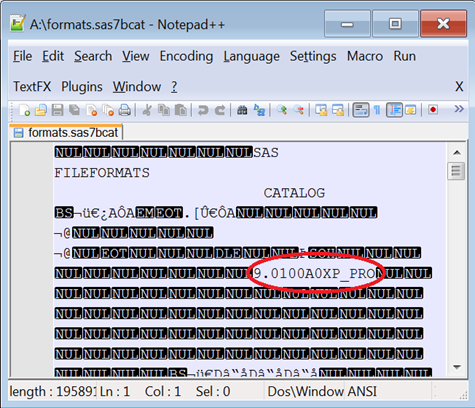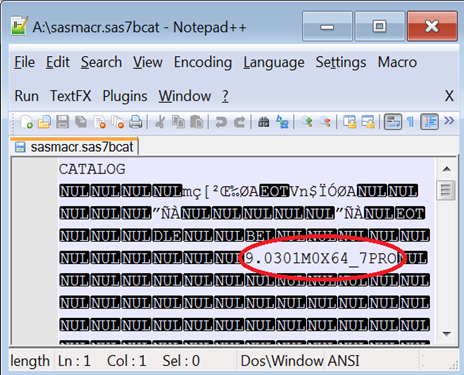SAS Sample 34444(Determine the operating system in which a format catalog was created) posts piece of codes to get the version of SAS and OS of a SAS format catalog. It is useful since a SAS catalog can be only read in the operating systems same to its source machine.
2 cents add to this note:
First, we do not need to write codes to get to know the machine version for a catalog(formats.sas7bcat or sasmacr.sas7bcat). Just open the catalog using a text editor, Notepad++, then you get
a SAS format catalog created by SAS 9.1 in a Windows XP Pro machine:
and a SAS macro catalog by SAS 9.3 in a 64 bits Windows 7 Pro machine:
Second, if do want programming (for curiosity purpose; I like this idea), we can also improve the sample codes since the position and length information were hard coded in Line 21 (the question is: how can we know that?):
test=substr(theline,210,20);
To get rid of hard coding, I use Perl Regular Expression. Just copy the archived codes for my SESUG 2012 talk with tiny modification (I always use the same programming blocks if possible):
https://github.com/Jiangtang/SESUG2012/blob/master/read_SAP.sas
The following codes can be also used to run against SAS macro catalog:
filename fmt “a:formats.sas7bcat”;
data fmt;
infile fmt lrecl=1000 truncover;
input line $1000.;
run;data null;
set fmt;
if n=1 then do;
retain queVer;ver=”/(\d+).[\d\w]+_[\d\w]+/”;
queVer = prxparse(ver);if missing(queVer) then do;
putlog “ERROR: Invalid regexp” ver;
stop;
end;
end;queVerN = prxmatch(queVer ,line);
if queVerN > 0 then do ;
call PRXsubstr(queVer,line,position,length);
version = compress(substr(line, position, length));
output;
end;put position= length=;
put version=;
run;
Test it against five Windows machines:
position=221 length=16
version=9.0301M1X64_7PROposition=217 length=15
version=9.0202M2NET_SRVposition=221 length=17
version=9.0202M3X64_SRV08position=217 length=14
version=9.0100A0XP_PROposition=217 length=15
version=9.0101M3NET_SRV
P.S.: The pattern (d+).[dw]+_[dw]+ can be read as
number(s) +
. +
some digits and words +
_ +
some digits and words
Since the underscore “_” is also included in meta-character w, it seems OK to simplify the pattern above to
(d+).[dw]+
But in a Window Server 2003 machine with SAS 9.2, it also returns the following unrelated information:
position=998 length=3
version=2.S

